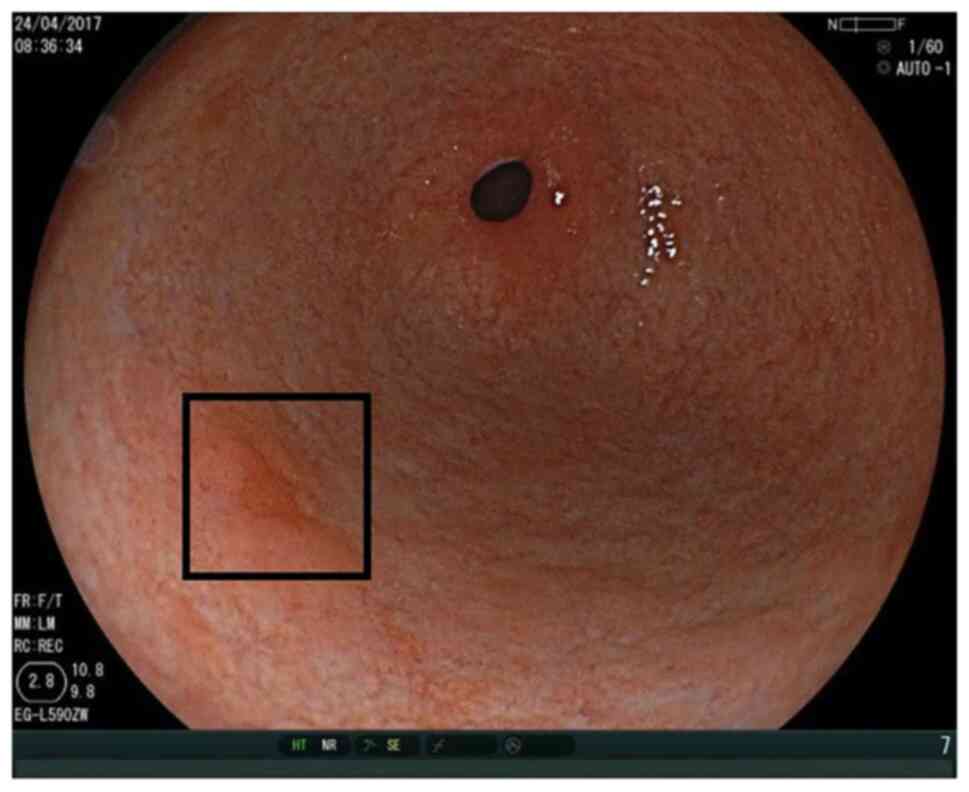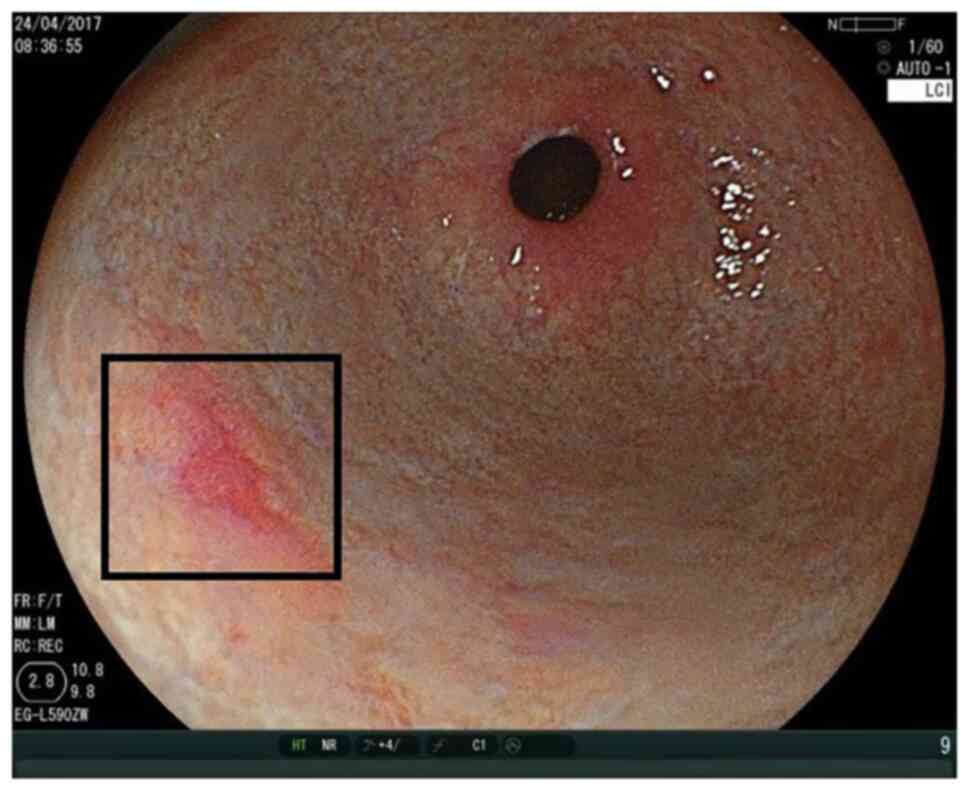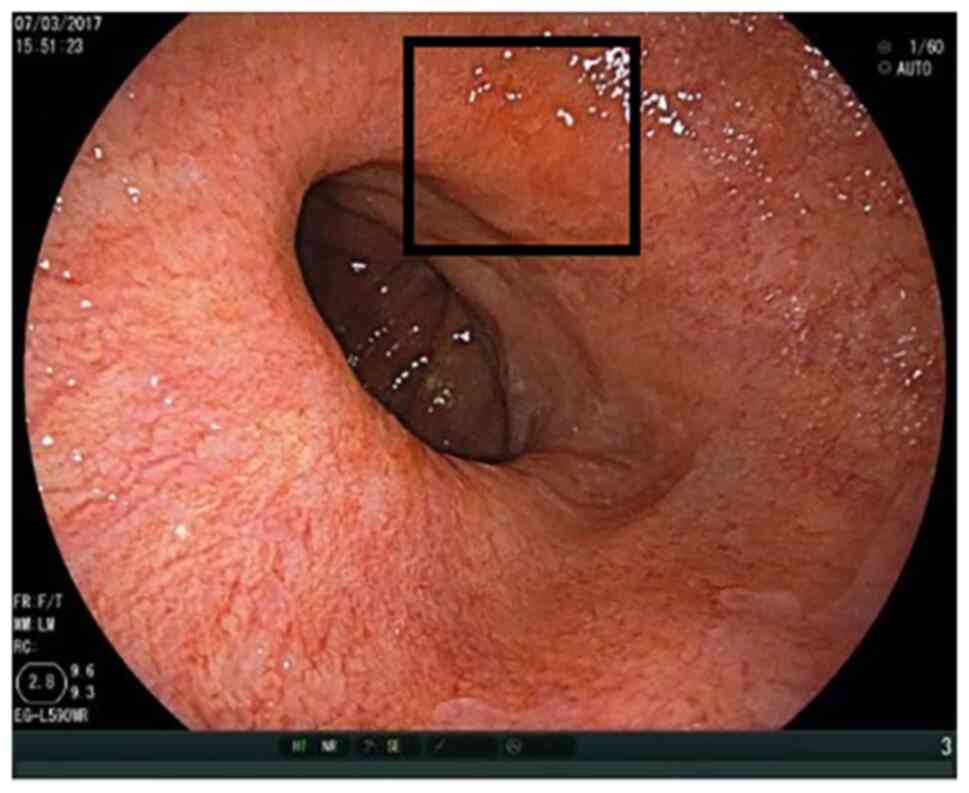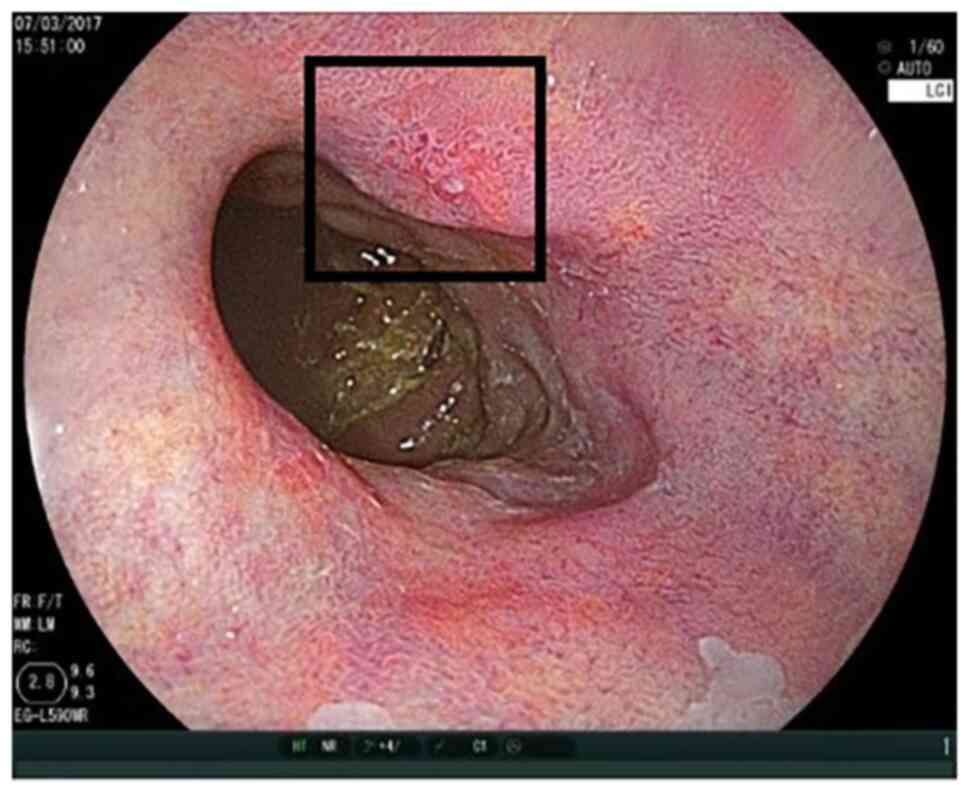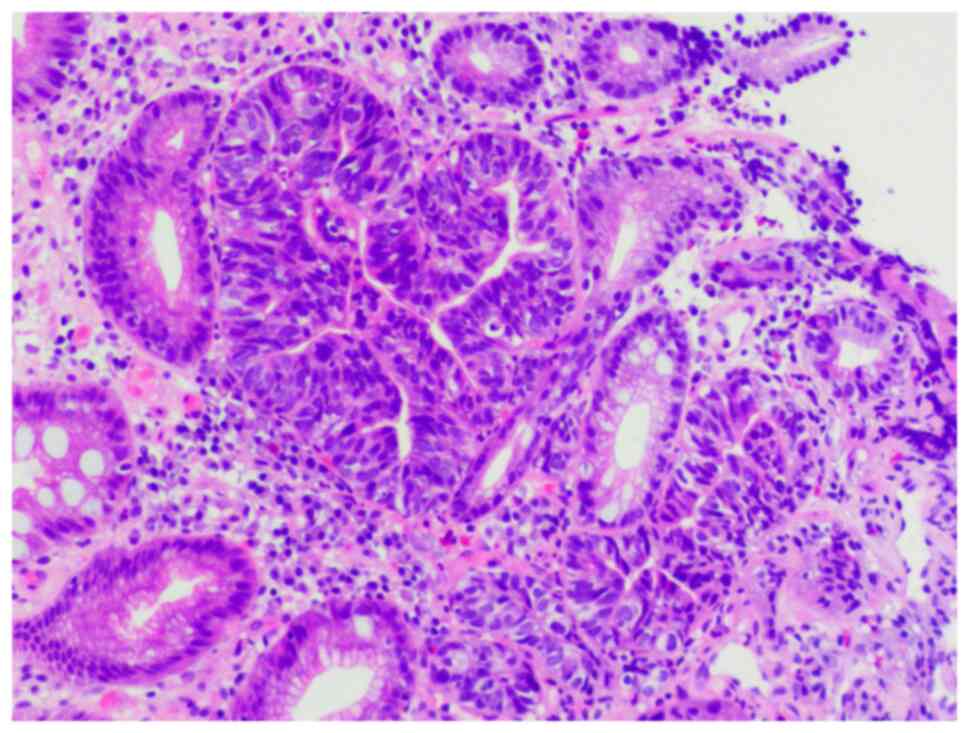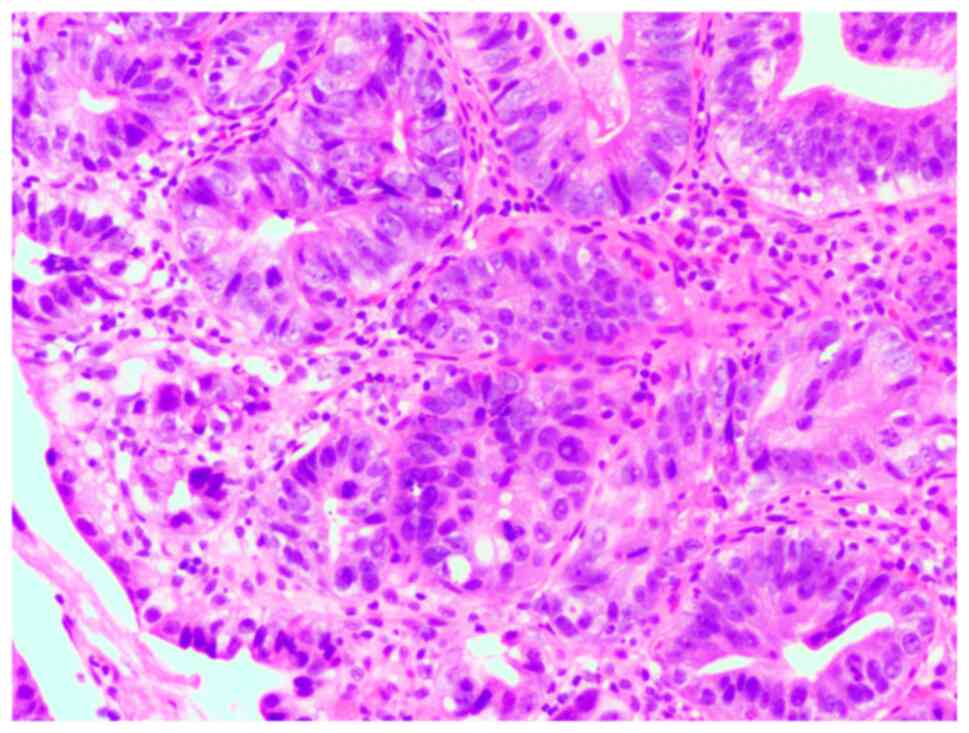|
1
|
Sung H, Ferlay J, Siegel RL, Laversanne M,
Soerjomataram I, Jemal A and Bray F: Global cancer statistics 2020:
GLOBOCAN estimates of incidence and mortality worldwide for 36
cancers in 185 countries. CA Cancer J Clin. 71:209–249.
2021.PubMed/NCBI View Article : Google Scholar
|
|
2
|
Yao K, Uedo N, Kamada T, Hirasawa T,
Nagahama T, Yoshinaga S, Oka M, Inoue K, Mabe K, Yao T, et al:
Guidelines for endoscopic diagnosis of early gastric cancer. Dig
Endosc. 32:663–698. 2020.PubMed/NCBI View Article : Google Scholar
|
|
3
|
Parkin DM, Bray F, Ferlay J and Pisani P:
Global cancer statistics, 2002. CA Cancer J Clin. 55:74–108.
2005.PubMed/NCBI View Article : Google Scholar
|
|
4
|
Tanabe S, Hirabayashi S, Oda I, Ono H,
Nashimoto A, Isobe Y, Miyashiro I, Tsujitani S, Seto Y, Fukagawa T,
et al: Gastric cancer treated by endoscopic submucosal dissection
or endoscopic mucosal resection in Japan from 2004 through 2006:
JGCA nationwide registry conducted in 2013. Gastric Cancer.
20:834–842. 2017.PubMed/NCBI View Article : Google Scholar
|
|
5
|
Young E, Philpott H and Singh R:
Endoscopic diagnosis and treatment of gastric dysplasia and early
cancer: Current evidence and what the future may hold. World J
Gastroenterol. 27:5126–5151. 2021.PubMed/NCBI View Article : Google Scholar
|
|
6
|
Nasu J, Doi T, Endo H, Nishina T, Hirasaki
S and Hyodo I: Characteristics of metachronous multiple early
gastric cancers after endoscopic mucosal resection. Endoscopy.
37:990–993. 2005.PubMed/NCBI View Article : Google Scholar
|
|
7
|
Loncroft-Wheaton G and Bhandari P: Image
enhanced endoscopy: Optical diagnosis or optical illusion? Saudi J
Gastroenterol. 25:71–72. 2019.PubMed/NCBI View Article : Google Scholar
|
|
8
|
Doyama H, Nakanishi H and Yao K:
Image-enhanced endoscopy and its corresponding histopathology in
the stomach. Gut Liver. 15:329–337. 2021.PubMed/NCBI View
Article : Google Scholar
|
|
9
|
Yoshida N, Doyama H, Yano T, Horimatsu T,
Uedo N, Yamamoto Y, Kakushima N, Kanzaki H, Hori S, Yao K, et al:
Early gastric cancer detection in high-risk patients: A multicentre
randomised controlled trial on the effect of second-generation
narrow band imaging. Gut. 70:67–75. 2021.PubMed/NCBI View Article : Google Scholar
|
|
10
|
Zhenming Y and Lei S: Diagnostic value of
blue laser imaging combined with magnifying endoscopy for
precancerous and early gastric cancer lesions. Turk J
Gastroenterol. 30:549–556. 2019.PubMed/NCBI View Article : Google Scholar
|
|
11
|
Onozato Y, Ishihara H, Iizuka H, Sohara N,
Kakizaki S, Okamura S and Mori M: Endoscopic submucosal dissection
for early gastric cancers and large flat adenomas. Endoscopy.
38:980–986. 2006.PubMed/NCBI View Article : Google Scholar
|
|
12
|
Fujimoto D, Muguruma N, Okamoto K, Fujino
Y, Kagemoto K, Okada Y, Takaoka Y, Mitsui Y, Kitamura S, Kimura T,
et al: Linked color imaging enhances endoscopic detection of
sessile serrated adenoma/polyps. Endosc Int Open. 6:E322–E334.
2018.PubMed/NCBI View Article : Google Scholar
|
|
13
|
Ono S, Abiko S and Kato M: Linked color
imaging enhances gastric cancer in gastric intestinal metaplasia.
Dig Endosc. 29:230–231. 2017.PubMed/NCBI View Article : Google Scholar
|
|
14
|
The Paris endoscopic classification of
superficial neoplastic lesions: Esophagus, stomach, and colon:
November 30 to December 1, 2002. Gastrointest Endosc. 58 (6
Suppl):S3–S43. 2003.PubMed/NCBI View Article : Google Scholar
|
|
15
|
Endoscopic Classification Review Group.
Update on the paris classification of superficial neoplastic
lesions in the digestive tract. Endoscopy. 37:570–578.
2005.PubMed/NCBI View Article : Google Scholar
|
|
16
|
Landis JR and Koch GG: The measurement of
observer agreement for categorical data. Biometrics. 33:159–174.
1977.PubMed/NCBI
|
|
17
|
Toyokawa T, Inaba T, Omote S, Okamoto A,
Miyasaka R, Watanabe K, Izumikawa K, Fujita I, Horii J, Ishikawa S,
et al: Risk factors for non-curative resection of early gastric
neoplasms with endoscopic submucosal dissection: Analysis of 1,123
lesions. Exp Ther Med. 9:1209–1214. 2015.PubMed/NCBI View Article : Google Scholar
|
|
18
|
Nakanishi H, Doyama H, Ishikawa H, Uedo N,
Gotoda T, Kato M, Nagao S, Nagami Y, Aoyagi H, Imagawa A, et al:
Evaluation of an e-learning system for diagnosis of gastric lesions
using magnifying narrow-band imaging: A multicenter randomized
controlled study. Endoscopy. 49:957–967. 2017.PubMed/NCBI View Article : Google Scholar
|
|
19
|
Fujiyoshi MRA, Inoue H, Fujiyoshi Y,
Nishikawa Y, Toshimori A, Shimamura Y, Tanabe M, Ikeda H and
Onimaru M: Endoscopic classifications of early gastric cancer: A
literature review. Cancers (Basel). 14(100)2021.PubMed/NCBI View Article : Google Scholar
|
|
20
|
Park JH, Lee KN, Lee HL, Jun DW, Yoon JH,
Lee OY, Yoon BC and Choi HS: Rates and risk factors for interval
gastric cancers at screening gastroscopy. Turk J Gastroenterol.
32:194–202. 2021.PubMed/NCBI View Article : Google Scholar
|
|
21
|
Chen MJ, Wu W, Pan S, Lin CJ, Dong LM,
Chen ZF, Wu JS and Huang ZM: Sedated gastroscopy improves detection
of gastric polyps. Exp Ther Med. 16:3116–3120. 2018.PubMed/NCBI View Article : Google Scholar
|
|
22
|
Zhu Y, Wang F, Zhou Y, Xia GL, Dong L, He
WH and Xiao B: Blue laser magnifying endoscopy in the diagnosis of
chronic gastritis. Exp Ther Med. 18:1993–2000. 2019.PubMed/NCBI View Article : Google Scholar
|
|
23
|
Yoshifuku Y, Sanomura Y, Oka S, Kurihara
M, Mizumoto T, Miwata T, Urabe Y, Hiyama T, Tanaka S and Chayama K:
Evaluation of the visibility of early gastric cancer using linked
color imaging and blue laser imaging. BMC Gastroenterol.
17(150)2017.PubMed/NCBI View Article : Google Scholar
|
|
24
|
Suzuki T, Hara T, Kitagawa Y, Takashiro H,
Nankinzan R, Sugita O and Yamaguchi T: Linked-color imaging
improves endoscopic visibility of colorectal nongranular flat
lesions. Gastrointest Endosc. 86:692–697. 2017.PubMed/NCBI View Article : Google Scholar
|















